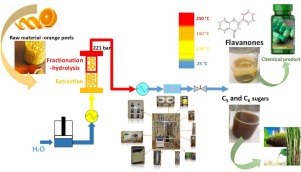The Journal of Supercritical Fluids ( IF 3.9 ) Pub Date : 2020-02-14 , DOI: 10.1016/j.supflu.2020.104789 Daniel Lachos-Perez , Andressa M. Baseggio , Paulo C. Torres-Mayanga , Patrícia F. Ávila , G.A. Tompsett , Mario Marostica , Rosana Goldbeck , Michael T. Timko , Mauricio Rostagno , Julian Martinez , Tânia Forster-Carneiro

|
The economically viable orange peel biorefinery can be based on a single process capable of extraction and hydrolysis. One of the major barriers in the OP biorefinery concept is the lack of an efficient separation technology for the complete removal of valuable components from the biomass. To address this issue, a new two-step hydrothermal process for sequential removal flavanones and sugars was evaluated. In the first stage, flavanones are extracted by subcritical water at 150 °C. The second stage consists of hydrolyzing the residual biomass at temperatures greater than 200 °C. The maximum flavanones yield (24.4 mg/g OP) was observed at a flow rate of 10 mL min–1. In the hydrolysis step, the main products were glucose, xylose, arabinose, and fructose, with small amounts of HMF and furfural. Spectroscopic and thermal analysis provided information on the bulk composition of the residual biomass and pectin extracted during hydrolysis temperatures above 200 °C.
中文翻译:

顺序亚临界水工艺应用于橙皮以回收黄烷酮和糖
经济可行的橙皮生物精炼厂可以基于能够提取和水解的单一工艺。OP生物精制概念的主要障碍之一是缺乏一种有效的分离技术,无法从生物质中完全去除有价值的成分。为了解决这个问题,评估了一种新的两步水热工艺,用于依次去除黄烷酮和糖。在第一阶段,在150°C下用亚临界水提取黄烷酮。第二阶段包括在高于200°C的温度下水解残留的生物质。在10 mL min –1的流速下观察到最大的黄烷酮产量(24.4 mg / g OP)。在水解步骤中,主要产物是葡萄糖,木糖,阿拉伯糖和果糖,以及少量的HMF和糠醛。光谱和热分析提供了有关水解温度高于200°C时提取的残余生物质和果胶的总体组成的信息。


























 京公网安备 11010802027423号
京公网安备 11010802027423号